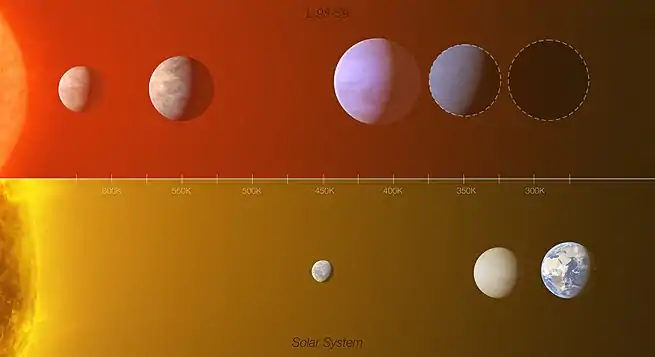L 98-59
L 98-59 (TOI-175, TIC 307210830) is a bright M dwarf star, located in the constellation of Volans, at a distance of 10.608 parsecs (34.60 light-years), as measured by Gaia.[3]
| Observation data Epoch J2000 Equinox J2000 | |
|---|---|
| Constellation | Volans |
| Right ascension | 08h 18m 07.62144s[1] |
| Declination | −68° 18′ 46.8054″[1] |
| Apparent magnitude (V) | 11.69±0.05[2] |
| Characteristics | |
| Evolutionary stage | Red dwarf (main sequence) |
| Spectral type | M3V |
| B−V colour index | +1.53[2] |
| R−I colour index | +1.28[2] |
| Variable type | None |
| Astrometry | |
| Radial velocity (Rv) | −6.10±0.19 km/s |
| Proper motion (μ) | RA: 94.794±0.018 mas/yr[1] Dec.: −340.084±0.020 mas/yr[1] |
| Parallax (π) | 94.2664 ± 0.0155 mas[1] |
| Distance | 34.599 ± 0.006 ly (10.608 ± 0.002 pc) |
| Details[3] | |
| Mass | 0.312±0.031 M☉ |
| Radius | 0.314±0.014 R☉ |
| Surface gravity (log g) | 4.94±0.06 cgs |
| Temperature | 3412±49 K |
| Metallicity [Fe/H] | –0.5±0.5 dex |
| Rotation | 78±13 d |
| Age | >1 Gyr |
| Other designations | |
2MASS J08180763-6818468, TOI-175, TYC 9193-2365-1, Gaia DR2 5271055243163629056 | |
| Database references | |
| SIMBAD | data |
Broadband photometry shows that it is an M3 dwarf star with four confirmed terrestrial-sized planets in transit, which were announced in March 2019 by TESS.[4][5]
In August 2021, new evidence was announced for a fifth, potentially habitable planet, labeled L 98-59 f. Though still unconfirmed,[6] this planet is believed to have 2.46 times Earth's mass, and an orbital period of 23.15 days.[7][8]
Planetary system
The two innermost planets, b and c, as well as L 98-59 e are possibly hot rocky worlds. L 98-59 c has an uncertain indications of atmosphere as in 2023.[9] L 98-59 d has large amounts of water, potentially as much as 30% of its entire mass, it may therefore have an ocean covering much of its surface.[7] The three inner planets were discovered in 2019.[4] The super-Venus planet L 98-59 e was discovered in 2021, along with potentially habitable (located in the middle of the habitable zone) super-Earth candidate L 98-59 f.[10] In September 2021, suggested tests of the abilities of the Hubble Space Telescope and the upcoming James Webb Space Telescope to detect and describe the atmospheric features of the three inner planets were reported.[11]
| Companion (in order from star) |
Mass | Semimajor axis (AU) |
Orbital period (days) |
Eccentricity | Inclination | Radius |
|---|---|---|---|---|---|---|
| b | 0.40+0.16 −0.15 M🜨 |
0.02191+0.00080 −0.00084 |
2.2531136+0.0000012 −0.0000015 |
0.103+0.117 −0.045 |
87.71+1.16 −0.44° |
0.85+0.061 −0.047 R🜨 |
| c | 2.22+0.26 −0.25 M🜨 |
0.0304+0.0011 −0.0012 |
3.6906777+0.0000016 −0.0000026 |
0.103+0.045 −0.058 |
88.11+0.36 −0.16° |
1.385+0.095 −0.075 R🜨 |
| d | 1.94±0.28 M🜨 | 0.0486+0.0019 −0.0019 |
7.4507245+0.0000081 −0.0000046 |
0.074+0.057 −0.046 |
88.449+0.058 −0.111° |
1.521+0.119 −0.098 R🜨 |
| e | >3.06+0.33 −0.37 M🜨 |
0.0717+0.0060 −0.0048 |
12.796+0.020 −0.019 |
0.128+0.108 −0.076 |
— | — |
| f (unconfirmed) | >2.46+0.66 −0.82 M🜨 |
0.1034+0.0042 −0.0044 |
23.15+0.60 −0.17 |
0.21+0.17 −0.11 |
— | — |
Gallery

See also
- List of potentially habitable exoplanets – Overview of potentially habitable terrestrial exoplanets
- List of exoplanets discovered in 2019
- TOI 700 d – Goldilocks terrestrial planet orbiting TOI-700
References
- Vallenari, A.; et al. (Gaia Collaboration) (2022). "Gaia Data Release 3. Summary of the content and survey properties". Astronomy & Astrophysics. arXiv:2208.00211. doi:10.1051/0004-6361/202243940. Gaia DR3 record for this source at VizieR.
- Zacharias, N.; Finch, C. T.; Girard, T. M.; Henden, A.; Bartlett, J. L.; Monet, D. G.; Zacharias, M. I. (1 February 2013). "The Fourth US Naval Observatory CCD Astrograph Catalog (UCAC4)". The Astronomical Journal. 145 (2): 44. arXiv:1212.6182. Bibcode:2013AJ....145...44Z. doi:10.1088/0004-6256/145/2/44. ISSN 0004-6256. S2CID 119299381.
- Cloutier, R.; Astudillo-Defru, N.; Bonfils, X.; Jenkins, J. S.; Berdiñas, Z.; Ricker, G.; Vanderspek, R.; Latham, D. W.; Seager, S.; Winn, J.; Jenkins, J. M. (2019-09-01). "Characterization of the L 98-59 multi-planetary system with HARPS - Mass characterization of a hot super-Earth, a sub-Neptune, and a mass upper limit on the third planet". Astronomy & Astrophysics. 629: A111. arXiv:1905.10669. Bibcode:2019A&A...629A.111C. doi:10.1051/0004-6361/201935957. hdl:1721.1/125703. ISSN 0004-6361. S2CID 166228063.
- Kostov, Veselin B.; Schlieder, Joshua E.; Barclay, Thomas; Quintana, Elisa V.; Colon, Knicole D.; Brande, Jonathan; Collins, Karen A.; Feinstein, Adina D.; Hadden, Samuel; Kane, Stephen R.; Kreidberg, Laura (2019-06-27). "The L 98-59 System: Three Transiting, Terrestrial-Sized Planets Orbiting a Nearby M-dwarf". The Astronomical Journal. 158 (1): 32. arXiv:1903.08017. Bibcode:2019AJ....158...32K. doi:10.3847/1538-3881/ab2459. hdl:1721.1/124742. ISSN 1538-3881. S2CID 118855908.
- "Comparison of the L 98-59 exoplanet system with the inner Solar System". European Southern Observatory. Retrieved 2021-08-07.
- "Comparison of the L 98-59 exoplanet system with the inner Solar System". www.eso.org. Retrieved 2021-08-09.
- "EarthSky | An inner solar system much like ours, 35 light-years away". Earth & Sky. 2021-08-06. Retrieved 2021-08-07.
- "New ESO observations show rocky exoplanet has just half the mass of Venus". European Southern Observatory. 5 August 2021. eso2112. Retrieved 8 August 2021.
- Barclay, Thomas; et al. (2023), The transmission spectrum of the potentially rocky planet L 98-59 c, arXiv:2301.10866
- Demangeon, Oliver D. S.; Zapatero Osorio, M. R.; Alibert, Y.; Barros, S. C. C.; Adibekyan, V.; Tabernero, H. M.; et al. (July 2021). "A warm terrestrial planet with half the mass of Venus transiting a nearby star" (PDF). Astronomy & Astrophysics. 653: 38. arXiv:2108.03323. Bibcode:2021A&A...653A..41D. doi:10.1051/0004-6361/202140728. S2CID 236957385.
- Pidhorodetska, Daria; et al. (29 September 2021). "L 98-59: A Benchmark System of Small Planets for Future Atmospheric Characterization". The Astronomical Journal. 162 (4): 169. arXiv:2106.00685. Bibcode:2021AJ....162..169P. doi:10.3847/1538-3881/ac1171. S2CID 235293792.
External links
- New ESO observations show rocky exoplanet has just half the mass of Venus (ESO press release)
- TESS – Official Website
- Smallest exoplanet found so far (video; 1:53; NASA; June 2019)






